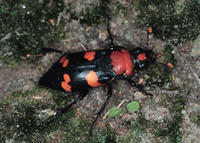AMERICAN BURYING BEETLE

This beetle is shiny black with the elytra (wing covers) having two orange-red markings. The most diagnostic feature of this beetle is the large orange-red markings on the raised portion of the pronotum. The species is up to 1.5 inches long. Historically, Kansas records exist in the eastern one-third of the state. The American Burying Beetles have been frequently found in upland grasslands or near the edge of grassland/forest. Sandy/clay loam soils and food (carrion) availability are also important. The species appears to prefer loose soil in which carrion can be easily buried. Since 1996, populations were found in four southeast counties in Kansas.

American Burying Beetles are protected by the Kansas Nongame and Endangered Species Conservation Act, the Federal Endangered Species Act, and state and federal regulations applicable to those acts. Any time an eligible project is proposed that will impact the species' preferred habitats within its probable range, the project sponsor must contact the Ecological Services Section, Kansas Department of Wildlife, Parks, and Tourism, 512 SE 25th Ave., Pratt, Kansas 67124-8174. Department personnel can then advise the project sponsor on permit requirements. Sponsors of projects impacting American Burying Beetle habitats must also contact the Endangered Species Office, U.S. Fish and Wildlife Service, 315 Houston Street, Suite E, Manhattan, Kansas 66502.
DESIGNATED CRITICAL HABITATS
As defined by Kansas Administrative Regulations, critical habitats include those areas documented as currently supporting self-sustaining population(s) of any threatened or endangered species of wildlife as well as those areas determined by the Kansas Department of Wildlife, Parks and Tourism to be essential for the conservation of any threatened or endangered species of wildlife.
Currently, Elk, Wilson, Montgomery, and Chautauqua counties are designated suitable critical habitat for the American Burying Beetle.
Elk
Montgomery
Wilson







